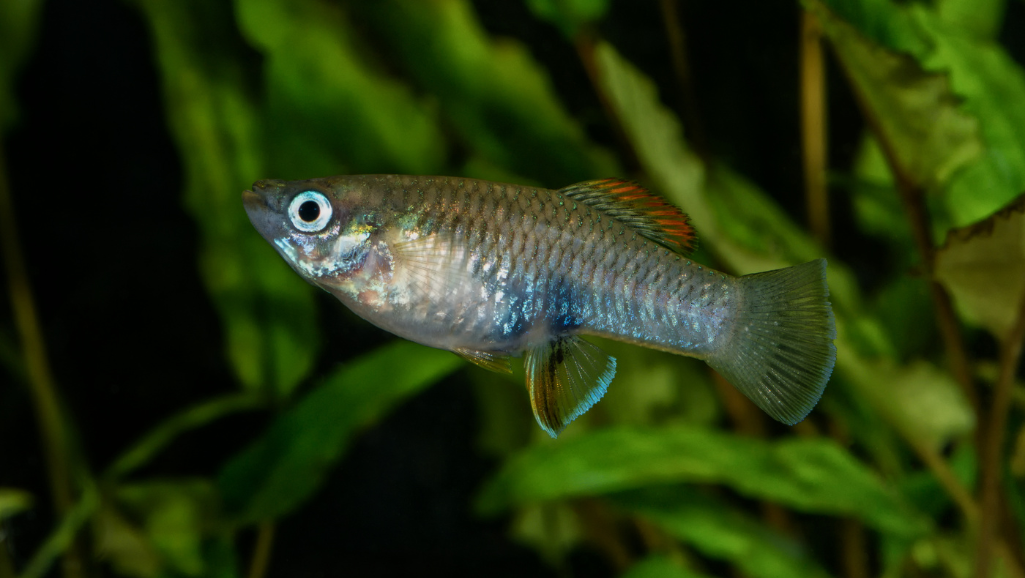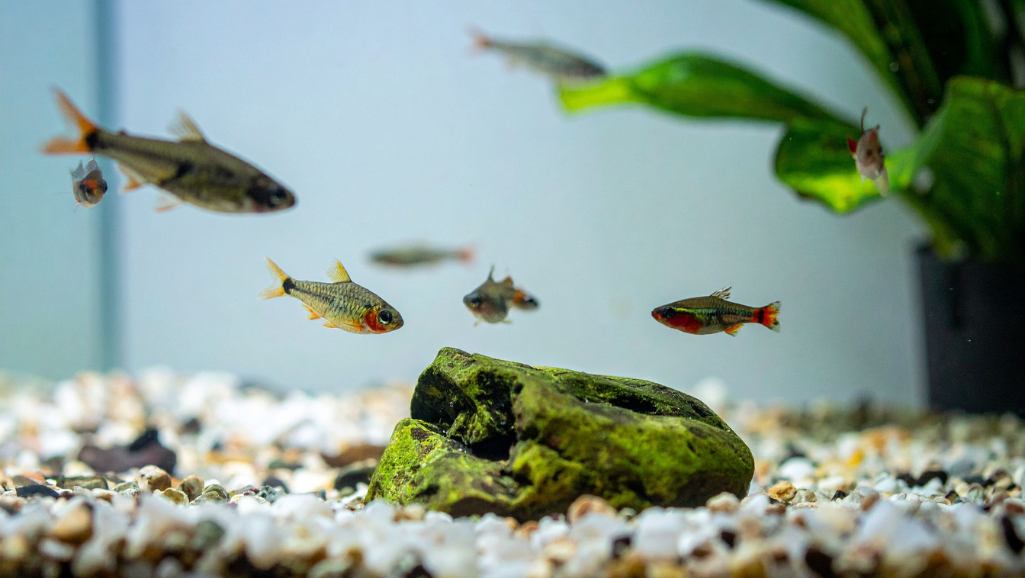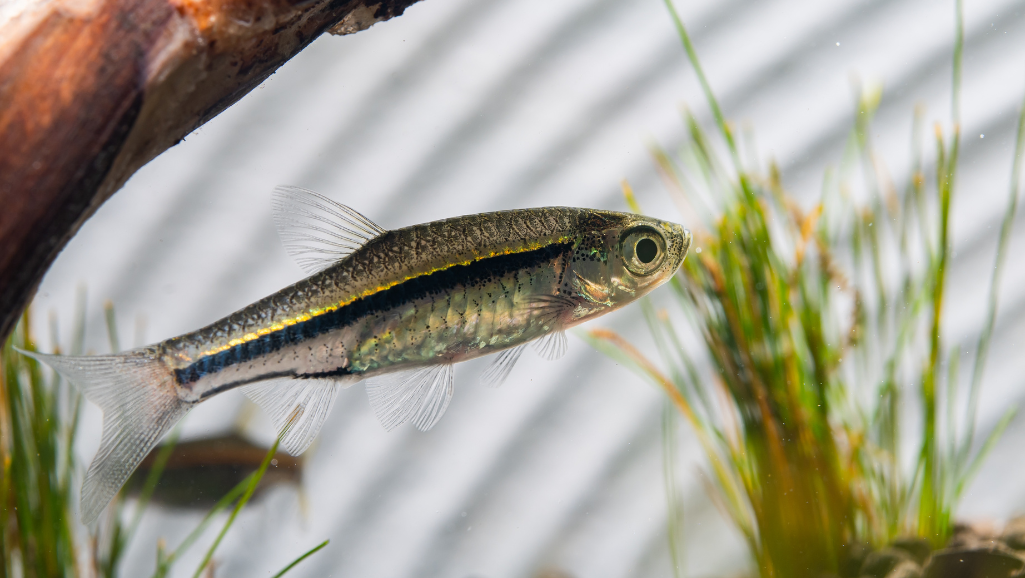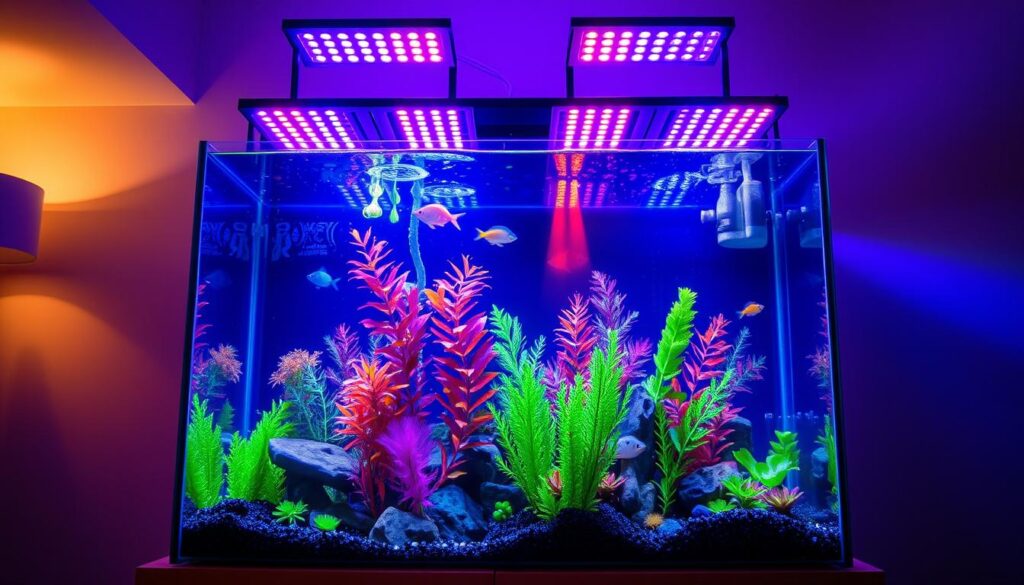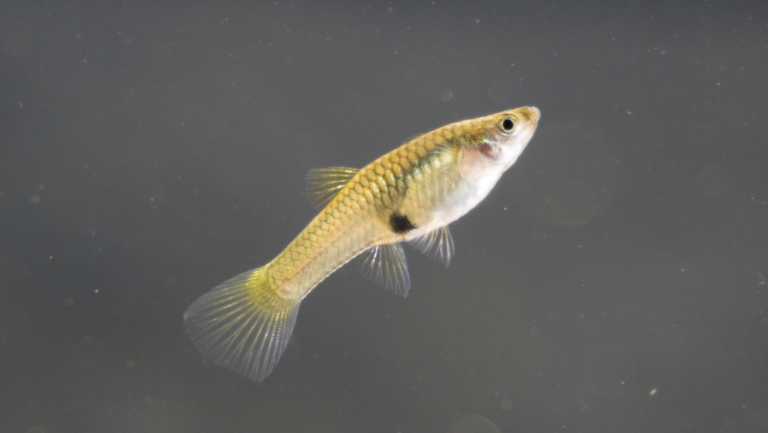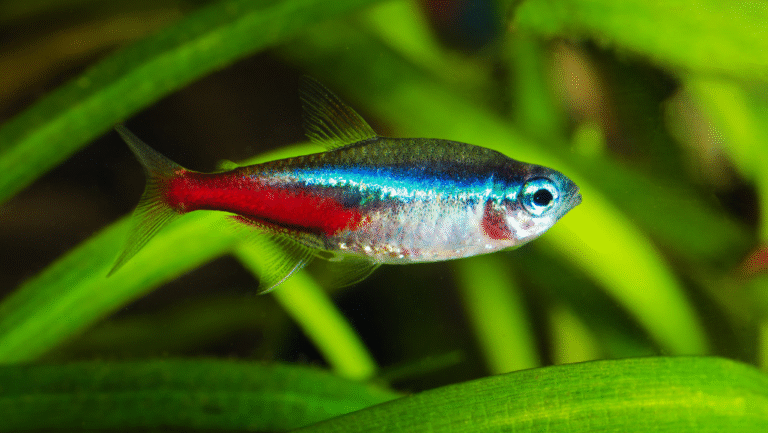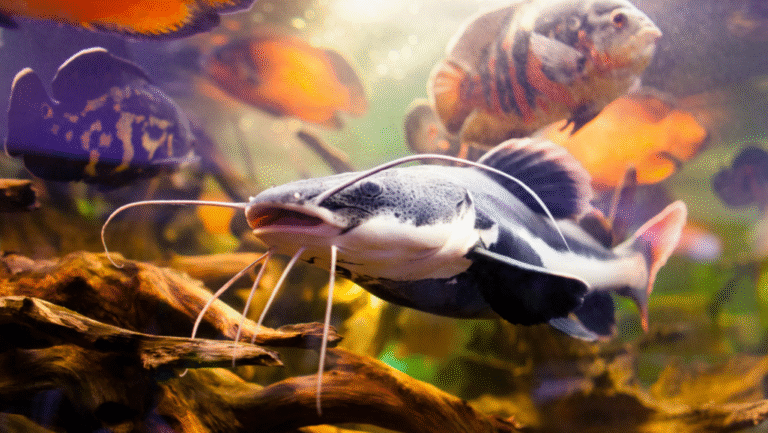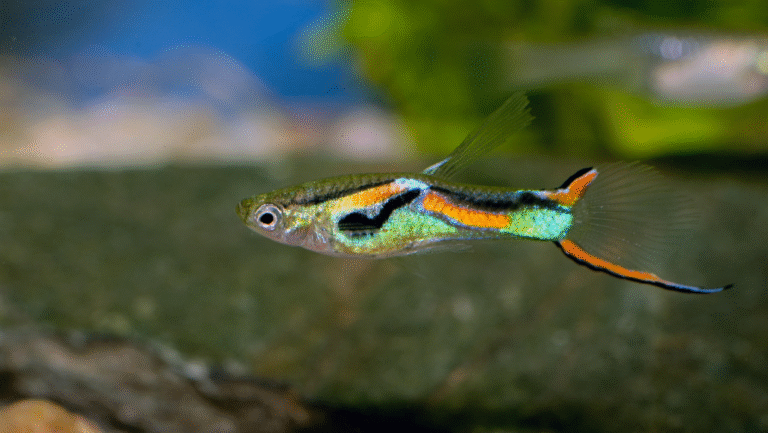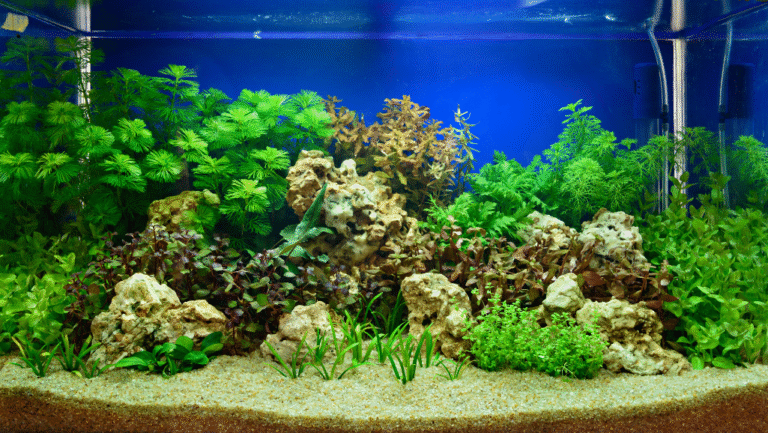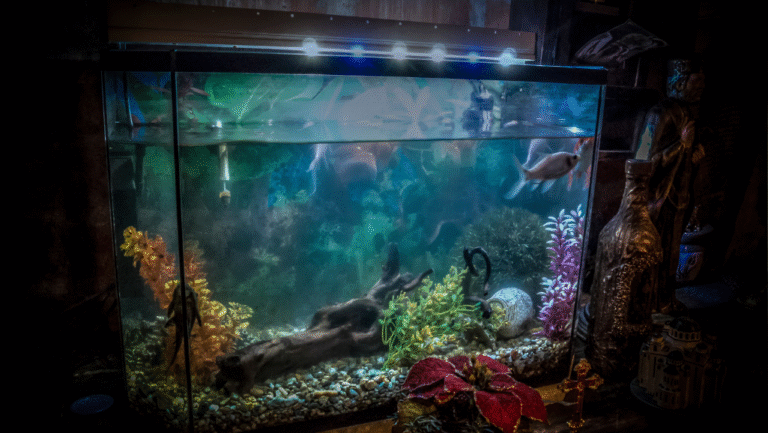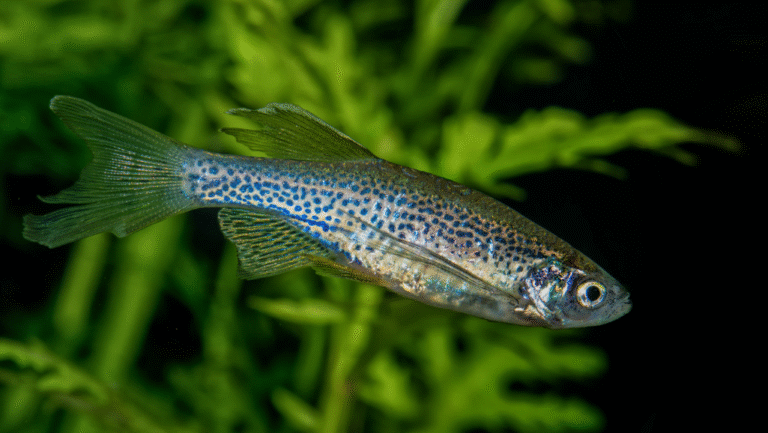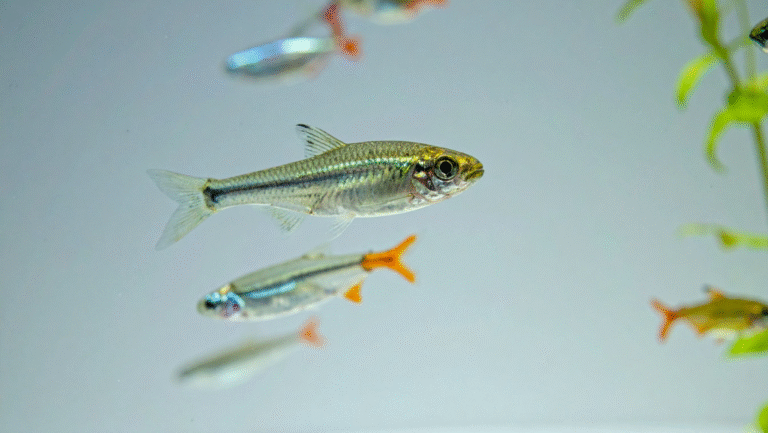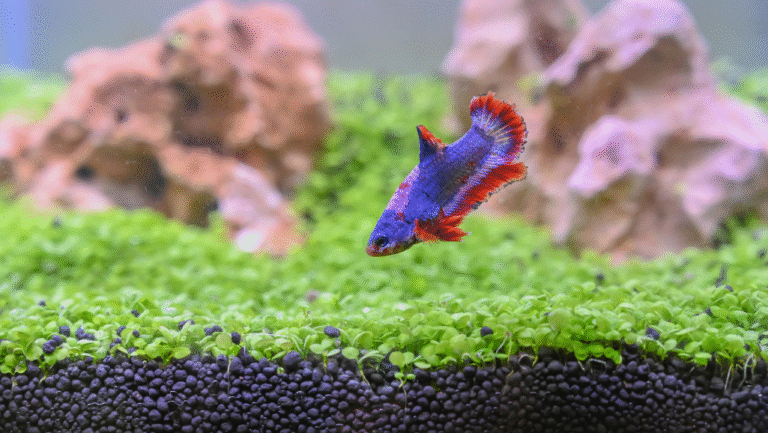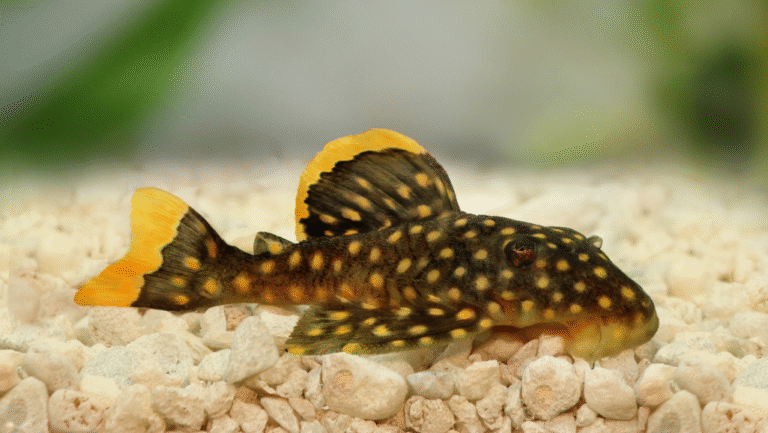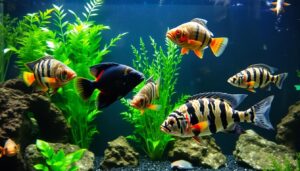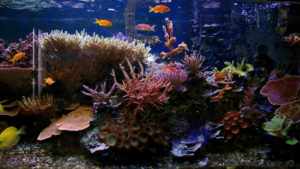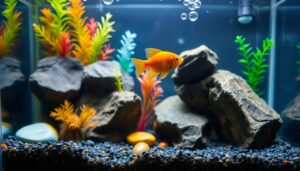Meet a small, shimmering fish that brings motion and color to any aquarium. Native to coastal rivers of Brazil, Guyana and Venezuela, this species is prized for its almost transparent body and tri-colored fins.
Adults top out near two inches and often live four to five years with steady care. They do best in a planted tank with sand, driftwood, and calm water around 75°F and pH 6.0–7.5.
As a schooling fish, these tetras shine in groups, moving as a living ribbon through foliage and open water. Their peaceful nature makes them a great fish for community setups.
Whether you are starting your first aquarium or refining a planted aquascape, this guide offers clear steps and practical tips. Learn setup, feeding, and routine care, plus links to deeper resources like this care overview: care and range details.
Key Takeaways
- Small, hardy species with striking transparent body and colorful fins.
- Best kept in schools and a planted, gently filtered tank.
- Ideal water: ~75°F, pH 6.0–7.5 for health and color.
- Adults reach about 1.75–2 inches and live 4–5 years with good care.
- Peaceful community fish that adapts well to thoughtful aquascapes.
Why Choose Pristella Tetra for Your Community Aquarium
In community aquariums, this species adds gentle activity without causing stress. They are peaceful, resilient, and low-maintenance—ideal for hobbyists who want lively movement without extra work.
Schooling behavior is key: keep them in groups so they feel secure and display fuller colors and natural foraging. A confident group also reduces skittishness and helps the whole tank stay calm.
Compatibility matters. These fish coexist well with small, non-aggressive tankmates. Avoid aggressive barbs and large predators that nip fins or create stress.
Maintenance is simple: stable water parameters, balanced feeding, and routine care let you enjoy their presence in living rooms, offices, or classrooms. Their commercial availability makes it easy to add healthy stock and build cohesive groups over time.
- Peaceful and easy to keep—great fish for beginners and experts alike.
- Best in groups—more activity and brighter colors when comfortable.
- Community-friendly—pair with small rasboras, Corydoras, and peaceful tetras.
- Care and availability—learn more on this care guide: care and availability.
Know Your Fish: Species Summary and Natural “X-Ray” Appeal
With a near-transparent body and vivid fin stripes, this species adds delicate motion and color to midwater zones.
Classification, distribution, and adaptable nature
Scientifically known as Pristella maxillaris, it sits in the order Characiformes and family Characidae as the sole member of its genus. Native range includes coastal waters of Venezuela, Guyana, Suriname, French Guiana, and northern Brazil.
Seasonal waters shape its resilience: clear streams in dry months and flooded savannahs in the rainy season. That adaptability helps when acclimating groups to varied tank hardness and pH.
Appearance and signature fin colors under natural and blue light
The silvery, almost translucent body gives the “x-ray” look. Dorsal and anal fins show yellow, black, and white bands, while the caudal fin leans red-pink.
Under blue lighting those bands and tail glow subtly, offering dramatic color without appearing artificial.
Average size and lifespan of adults in home tanks
Adults typically reach about 40–45 mm (roughly 1.75–2 inches), ideal for planted aquascapes that mix open lanes and leaf cover.
Life expectancy in good captive care is usually 4–5 years. Most fish for sale are commercially bred, which supports steady availability and robust lines.
- Accepts a variety of foods: flakes, micro granules, and protein treats for conditioning.
- Shows clear group behavior: schooling improves color and confidence.
- Females appear stockier and may show eggs when conditioned for spawning.
Setting Up the Tank: From First Fill to Happy School
Provide a midwater highway and soft edges, and your school will reward you with calm, natural movement. “Plan space first; the rest follows.”
Recommended size: start with at least a 10-gallon tank for a small shoal, but aim for 15–20 gallons so the fish can swim freely and bioload stays manageable.
Keep open swimming lanes in the center. Place plants and driftwood around the margins for cover. A sand substrate and leaf litter create a natural environment.
Filter, cycle, and flow
Choose a reliable filter and complete a full nitrogen cycle before adding tetras. Stable, gentle flow supports midwater cruising and reduces stress.
“Make sure conditions are steady from day one to encourage feeding, color, and long-term care.”
- Group at least six to reduce skittishness and boost natural schooling.
- Use Indian almond leaves for tannins and microhabitats.
- Thoughtful setup now helps with eggs or breeding readiness later.
Pristella Tetra Water Parameters Made Simple
Consistent tank conditions protect color, appetite, and schooling behavior in small freshwater species.
Temperature and targets for U.S. homes: Aim for the mid-70s Fahrenheit. The general range is 64–82°F, with ~75°F ideal for most lines. If you keep a GloFish variant, consider 76–80°F. Keep daily swings minimal to preserve feeding and group dynamics.
pH, hardness, and avoiding sudden swings
Maintain pH near 6.0–7.5 for easy stability, even though wild waters span roughly 5.8–8.5. Hardness around 4–8 KH works well; this species tolerates variability thanks to seasonal native waters.
- Test weekly with reliable kits and log results.
- Top off and do measured changes to protect the biofilter.
- Make sure your filter matches tank size and offers moderate flow for oxygen without stressing midwater swimmers.
“Stability outweighs chasing perfect numbers — pick a set point and keep it steady.”
Use a quality thermometer and liquid test kits, especially in U.S. homes with seasonal HVAC shifts. A steady environment helps small fish show color, feed confidently, and resist illness.
Aquascape That Inspires: Plants, Leaves, Wood, and Light
Build a nature-like layout that pairs soft sand with wood and lush plants for a calm, tea-colored scene.
Substrate and tannins: Choose fine sand to anchor roots and give the tank a natural floor. Slip a few Indian almond leaves into the water to add gentle tannins that mimic seasonal waters and support microfauna.
Plants and structure: Plant Java fern and Amazon sword along the back and sides. Add floating cover for dappled shade and use rock caves or driftwood to make quiet hiding spots.
Design tips for confident schooling
- Keep the center lane open so the school can cruise without obstacles.
- Arrange driftwood and roots to form shadowed pockets where shy fish can pause.
- Use subdued light to deepen fin contrast and calm active groups.
Why it works: This nature-forward aquarium echoes their native waters — leaf-stained and wood-laced — and creates an environment where fish become the focus and plants frame the scene.
Food and Feeding: Daily Nutrition They’ll Thrive On
A thoughtful feeding plan keeps your school energetic and your tank water clear. Proper daily meals support color, growth, and confident group behavior.
Staple foods: Offer high-quality flakes or micro granules that disperse in midwater. These staples suit omnivorous appetites and feed the whole school evenly.
Protein-rich treats to boost color
Rotate in small portions of live, frozen, or freeze-dried options—brine shrimp, daphnia, and bloodworms. These treats improve condition and encourage natural foraging.
Feeding frequency and portion control
Feed two to three times a day in amounts the group can finish in about 1–3 minutes. Make sure portions stay modest to protect water quality and the biofilter.
“Consistent feeding discipline keeps behavior lively without overloading filters.”
- Watch how your group feeds — synchronized pecking shows comfort.
- Pair feeding times with lights-on periods to reduce waste.
- A varied menu supports immune health and brighter fins.
Good care at the dinner bell ripples into better growth and calmer, more confident fish in your planted tank.
Behavior, Schooling, and Community Tank Mates
A confident school changes a tank’s mood—watch nervous darting become calm, coordinated motion. Keep groups together to let natural behavior emerge. A well-sized group reduces stress and highlights color.
Plan for a group of at least six to unlock tight schooling and smoother movement across midwater. Larger groups further lower skittishness and help shy fish rejoin the school quickly.
Temperament and group dynamics
These fish are peaceful and prefer calm community tanks. Subtle pecking order interactions are normal and rarely escalate when numbers are adequate.
Compatible species
- Small tetras and rasboras that share midwater habits
- Pencilfish, hatchetfish, and quiet Corydoras on the bottom
- Small loricariids and non-aggressive dwarf cichlids (Apistogramma-style) that won’t harass them
What to avoid
Avoid large predators, many cichlids, and some barbs that nip fins or chase smaller species. These mismatches stress the group and harm tank harmony.
“Provide open lanes and scattered hiding spots so timid individuals can reset and rejoin the school.”
Curate a balanced community with intention and your tank becomes a living artwork—calm, colorful, and endlessly engaging.
Health and Care: Preventing Problems Before They Start
Healthy tanks begin with simple routines that catch problems before they escalate. Watch your group daily for subtle changes. Quick action saves time and reduces stress for everyone in the environment.
Common signs and quick recognition
Look for white spots, flashing, clamped fins, faded color, or lethargy. These often signal Ich, external parasites, or bacterial disease.
Early detection lets most common issues respond well to over-the-counter treatments. Quarantine affected fish at the first sign to protect the rest of the community.
Proactive routines that work
- Test water weekly and log results to spot drifting conditions early.
- Do ~25% water changes every two weeks to dilute wastes and stabilize chemistry.
- Rinse filter media gently in tank water to keep beneficial bacteria intact.
- Use a separate container and nets for new arrivals to prevent cross-contamination.
“Steady care beats emergency cures — prevention is the best medicine.”
This short guide emphasizes prevention. Document symptoms and readings before treating, and keep routines consistent. A calm, clean setup and a cycled filter give fish the best chance to thrive.
Breeding Pristella Tetra at Home
Breeding at home is about timing, gentle conditions, and patient observation. Start with a dedicated 10+ gallon spawning tank set to soft, slightly acidic water. Use peat or RO to lower hardness and mimic wet-season chemistry.
Conditioning the pair
Conditioning pairs with live and frozen foods
Choose a healthy male and female and feed small, protein-rich food twice daily for a week. Live daphnia, brine, and frozen foods sharpen color and prime females for egg development.
Spawning setup: soft water, fine-leaf plants, and light control
Provide fine-leaved plants or spawning mops and cover filter inlets with a sponge. Keep the light dim — eggs and early fry are very light sensitive. Gentle flow and stable temperature help eggs settle.
Egg care and raising fry: infusoria to baby brine shrimp
After spawning the selected pair, females may lay 300–400 eggs. Remove adults right away; they will eat the eggs. Eggs hatch in about 24–36 hours and fry swim freely in 3–4 days.
- Begin feeding infusoria or fine powdered foods immediately when fry are free-swimming.
- Transition to baby brine shrimp as mouths grow and feeding improves.
- Softer water and lower hardness often raise hatch rates and fry health.
“Careful setup, consistent feeding, and patient observation create the best path from courtship to strong, growing fry.”
Shopping Smart: Standard, “Golden,” and GloFish Pristella Options
Shopping for these lively midwater swimmers is about spotting vigor, not just bright fins. Pick fish that swim steadily in midwater and respond when food arrives.
Choosing healthy fish for sale and acclimation tips
Signs of a healthy purchase: clear eyes, intact fins, a streamlined body, and steady midwater swimming. These traits show good size and vigor at the store.
Acclimate slowly: match temperature first, then drip or mix water gradually to align chemistry before release. This reduces stress and helps fish settle into your aquarium.
GloFish colors, lighting, and feeding notes
GloFish variants come in Starfire Red, Sunburst Orange, Electric Green, and Galactic Purple. Their fluorescence is strongest under blue LED or black light.
- Keep GloFish at 76–80°F for best color and activity.
- Feed small portions two to three times daily with micro flakes or crisps that suspend in midwater.
- Note: GloFish lines are FDA-regulated; breeding, production, or sale of offspring without authorization is prohibited.
“Choose calm tank mates and a planted layout that flatters color and reduces stress.”
Quick buying checklist: avoid aggressive species (including some barbs), prefer commercially bred stock, and pick the form—standard, golden, or fluorescent—that fits your display goals.
Conclusion
Steady routines and thoughtful design turn a modest aquarium into a calm, colorful community that rewards daily care.
This guide shows how simple choices—stable water conditions near 75°F and pH 6.0–7.5, a planted, wood-accented scape, and keeping groups—give the species a chance to thrive. Adults reach about 2 inches, so plan space and planting with size in mind.
Breeding can be a satisfying project. Use soft water, fine-leaf plants, and a quiet pair setup to protect eggs and raise fry with gentle light and small foods.
Let this resource be your springboard. Commit to steady care, celebrate small wins, and watch your pristella tetra community grow. Thanks for reading and good luck with your tank.
